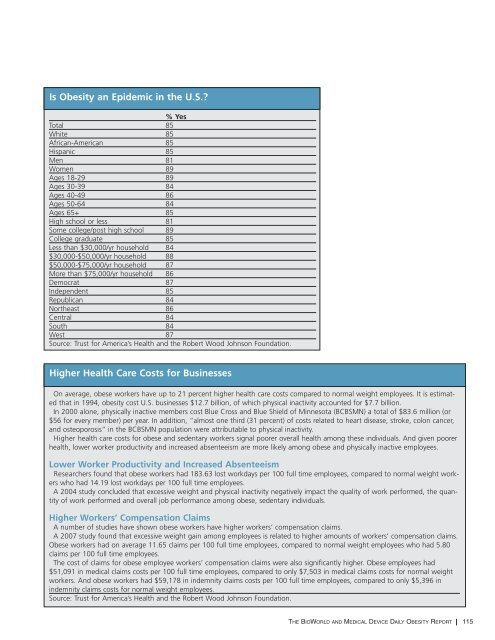Create successful ePaper yourself
Turn your PDF publications into a flip-book with our unique Google optimized e-Paper software.
Is Obesity an Epidemic in the U.S.?<br />
% Yes<br />
Total 85<br />
White 85<br />
African-American 85<br />
Hispanic 85<br />
Men 81<br />
Women 89<br />
Ages 18-29 89<br />
Ages 30-39 84<br />
Ages 40-49 86<br />
Ages 50-64 84<br />
Ages 65+ 85<br />
High school or less 81<br />
Some college/post high school 89<br />
College graduate 85<br />
Less than $30,000/yr household 84<br />
$30,000-$50,000/yr household 88<br />
$50,000-$75,000/yr household 87<br />
More than $75,000/yr household 86<br />
Democrat 87<br />
Independent 85<br />
Republican 84<br />
Northeast 86<br />
Central 84<br />
South 84<br />
West 87<br />
Source: Trust for America’s Health and the Robert Wood Johnson Foundation.<br />
Higher Health Care Costs for Businesses<br />
On average, obese workers have up to 21 percent higher health care costs compared to normal weight employees. It is estimated<br />
that in 1994, obesity cost U.S. businesses $12.7 billion, of which physical inactivity accounted for $7.7 billion.<br />
In 2000 alone, physically inactive members cost Blue Cross and Blue Shield of Minnesota (BCBSMN) a total of $83.6 million (or<br />
$56 for every member) per year. In addition, “almost one third (31 percent) of costs related to heart disease, stroke, colon cancer,<br />
and osteoporosis” in the BCBSMN population were attributable to physical inactivity.<br />
Higher health care costs for obese and sedentary workers signal poorer overall health among these individuals. And given poorer<br />
health, lower worker productivity and increased absenteeism are more likely among obese and physically inactive employees.<br />
Lower Worker Productivity and Increased Absenteeism<br />
Researchers found that obese workers had 183.63 lost workdays per 100 full time employees, compared to normal weight workers<br />
who had 14.19 lost workdays per 100 full time employees.<br />
A 2004 study concluded that excessive weight and physical inactivity negatively impact the quality of work performed, the quantity<br />
of work performed and overall job performance among obese, sedentary individuals.<br />
Higher Workers’ Compensation Claims<br />
A number of studies have shown obese workers have higher workers’ compensation claims.<br />
A 2007 study found that excessive weight gain among employees is related to higher amounts of workers’ compensation claims.<br />
Obese workers had on average 11.65 claims per 100 full time employees, compared to normal weight employees who had 5.80<br />
claims per 100 full time employees.<br />
The cost of claims for obese employee workers’ compensation claims were also significantly higher. Obese employees had<br />
$51,091 in medical claims costs per 100 full time employees, compared to only $7,503 in medical claims costs for normal weight<br />
workers. And obese workers had $59,178 in indemnity claims costs per 100 full time employees, compared to only $5,396 in<br />
indemnity claims costs for normal weight employees.<br />
Source: Trust for America’s Health and the Robert Wood Johnson Foundation.<br />
THE BIOWORLD AND MEDICAL DEVICE DAILY OBESITY REPORT 115

















